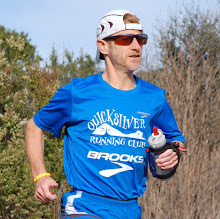With the new year came the new Grand Prix and its variety of distances, terrains and course profiles so I had to retrain on hills in particular and let go of the focus on the track marathon benchmarking. With the Grand Prix successfully completed I'm now working on speed again and Coros finally noticed, lowering its marathon prediction time to 3:06:57. As I regain self-confidence and rebuilt some leg strength, I felt that I could even beat that. At least give it a try. This Sunday. And at the brand new track!
Cupertino High School got a new synthetic track and football field when our son Max was attending, 20 years ago, in 2005. Last June, work started for a major make over of the football fields. Construction engines were damaging the track so I was hoping they'd redo it too. Which they did indeed, starting on back to school week as a matter of fact. Fast forward 2 months and the track opened this past week! (Picture from last weekend.) What a treat!
I invited my running buddy, Bob, to pace me at the start. Bob ran the first 6 miles with me and put me on the 1'45"-lap rhythm, a 7 min/mile pace orbit. While I was hoping to cover the marathon distance at that pace, my overall goal was to see how long I could hold that pace, either shorter or longer.
Ironically, as it was about to show Coros what I was really capable of on the marathon, I had charged my watch the night before but misplaced it afterwards and couldn't find it as I was rushing out early on Sunday morning, duh! Instead, I used my old Garmin Forerunner 310XT which isn't the best for distance accuracy but has a great auto-lap counting mode. Keeping track of the number of distance-certified laps is the best way to get the actual mileage, as a mater of mathematical fact. 42,195 meters divided by 400 equals 105.4875 laps!
After 10 miles (40 laps), I stopped checking lap time at every lap and ran more by feel. I'm stunned to see in the log, afterwards, that lap 77 was the first one in that internal above 1:45, at 1:48. All other laps were in the [-3 , 0] seconds range, showing why doing speed workouts on a track is so important to maintain a stable pace, in a safe environment.
Lap 85 is when I started to show signs of fatigue, losing a few seconds at each lap, for a total of 36 seconds over the last 22 laps.
The glutes and hamstrings were getting stiffer so I decided to stop after the marathon mark, completing 106 laps in 3:04:51 (26.346 miles, 7:01 min/mile pace). Because I used my Garmin watch, Coros hasn't revised it's 3:06:57 prediction, even after I uploaded that activity which shows a distance of 27.52 miles. I will have to do it again with that Coros watch so it believes me...!
Short of all the Coros metrics (cadence, stride length, hearth rate, ...), I include the long list of lap stats (per the above note, distances and paces being slightly off with this old watch, especially on the track).
The experiment continues... and hard work too!







No comments:
Post a Comment